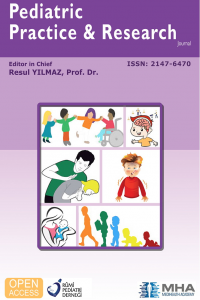Çocukluk Çağı Beyin Sapı Tümörleri
Beyin sapı tümörleri, çocukluk çağı, radyoterapi, kemoterapi
Brainstem Tumor in Children
Brainstem tumor, children, radiotherapy, chemotherapy,
___
- KAYNAKÇA 1. Jallo GI, Biser-Rohrbaugh A, Freed D. Brainstem gliomas. Childs Nerv Syst. 2004; 20(3): 143–53.
- 2. Başarır M, Özek M. Beyin sapı tümörlerinde güncel tedavi seçenekleri. Türk Nöroşir Derg 2017; 27(1): 43-51.
- 3. Robison NJ, Kieran MW. Diffuse intrinsic pontine glioma: a reassessment. J Neurooncol. 2014; 119(1): 7–15.
- 4. Monje M, Mitra SS, Freret ME et al. Hedgehog-responsive candidate cell of origin for diffuse intrinsic pontine glioma. Proc Natl Acad Sci U S A. 2011 Mar 15;108(11):4453
- 5. Fisher PG, Breiter SN, Carson BS, et al. A clinicopathologic reappraisal of brain stem tumor classification. Identification of pilocystic astrocytoma and fibrillary astrocytoma as distinct entities. Cancer. 2000 Oct 1;89(7):1569-76.
- 6. Albright AL. Diffuse brainstem tumors: when is a biopsy necessary? Pediatr Neurosurg. 1996;24(5):252-5.
- 7. El-Khouly FE, Veldhuijzen van Zanten SEM, Santa-Maria Lopez V, et al. Diagnostics and treatment of diffuse intrinsic pontine glioma: where do we stand?. J Neurooncol. 2019; 145(1):177–184.
- 8. Veldhuijzen van Zanten SEM, Baugh J, Chaney B, et al. Development of the SIOPE DIPG network, registry and imaging repository: a collaborative effort to optimize research into a rare and lethal disease. J Neurooncol. 2017; 132(2): 255–266.
- 9. Broniscer A, Laningham FH, Kocak M, et al. Intratumoral hemorrhage among children with newly diagnosed, diffuse brainstem glioma. Cancer. 2006 Mar 15;106(6):1364-71
- 10. Epstein F, Constantini S. Practical decisions in the treatment of pediatric brain stem tumors. Pediatr Neurosurg. 1996;24(1):24-34.
- 11. Schild SE, Stafford SL, Brown PD, et al. The results of radiotherapy for brainstem tumors. J Neurooncol. 1998 Nov;40(2):171-7.
- 12. Jalali R, Raut N, Arora B, et al. Prospective evaluation of radiotherapy with concurrent and adjuvant temozolomide in children with newly diagnosed diffuse intrinsic pontine glioma. Int J Radiat Oncol Biol Phys. 2010; 77(1): 113–118.
- 13. Kebudi R, Cakir FB, Agaoglu FY, et al. Pediatric diffuse intrinsic pontine glioma patients from a single center. Childs Nerv Syst. 2013; 29(4): 583–588.
- 14. Hargrave D, Bartels U, Bouffet E. Diffuse brainstem glioma in children: critical review of clinical trials. Lancet Oncol. 2006 Mar;7(3):241-8.
- 15. Kebudi R, Cakir FB. Management of diffuse pontine gliomas in children: recent developments. Paediatr Drugs. 2013; (5):351–362.
- ISSN: 2147-6470
- Başlangıç: 2013
- Yayıncı: MediHealth Academy Yayıncılık
Türkiye’de Anne/Baba-Bebek Bağlanmasını Belirlemeye Yönelik Kullanılan Ölçekleri İnceleme
Ayşe ÇATALOLUK, Ayşenur KAHRAMAN, Özgür ALPARSLAN
Çocuk Acil Servise Düşmeye Bağlı Travma Nedeniyle Getirilen Olgular
İlknur FİDANCI, Okşan DERİNÖZ, Aslıhan TOKGÖZ
Çocuklarda COVID-19 ve Karaciğer
Anna Carina ERGANİ, Reyhan GÜMÜŞTEKİN, Meltem GÜMÜŞ, Halil Haldun EMİROĞLU
Sezaryen ile Doğan Bebeklerde Alerji Görülme Sıklığının Değerlendirilmesi
İzzet FİDANCI, Eribenur ÖTEGEN, Halise KEÇİK, Rumeysa Betül YILMAZ, Zehra Nur YAĞLI, Hilal AKSOY, Duygu AYHAN BAŞER, Mustafa CANKURTARAN
Adolesan Bir Hastada Atriyal Miksomanın Nadir Bir Prezentasyonu: Bir Olgu Sunumu
Emine AKKUZU, Şahin SİNCAR, Semiha TOKGÖZ, Gökhan KALKAN
Çocukluk Çağı Beyin Sapı Tümörleri
Buket KARA, Güler YAVAŞ, Yavuz KÖKSAL
Reyhan GÜMÜŞTEKİN, Anna Carina ERGANİ, Meltem GÜMÜŞ, Halil Haldun EMİROĞLU
Çocuklarda görülen saç ve saçlı deri hastalıklarının değerlendirilmesi
COVİD-19: Pediatrik Açıdan Bakış
Meltem GÜMÜŞ, Reyhan GÜMÜŞTEKİN, Anna Carina ERGANİ, Halil Haldun EMİROĞLU
Bir Pediatri Kliniğinde COVID-19 Pandemi Yönetimi
Sevliya ÖCAL DEMİR, Gülser ESEN BESLİ, Sertaç ARSLANOĞLU, Fahri OVALI
